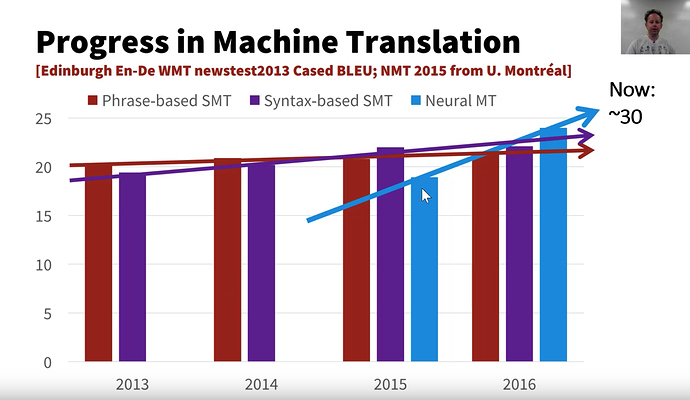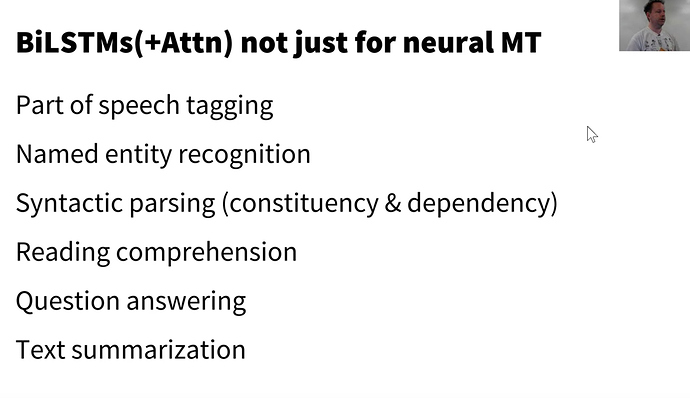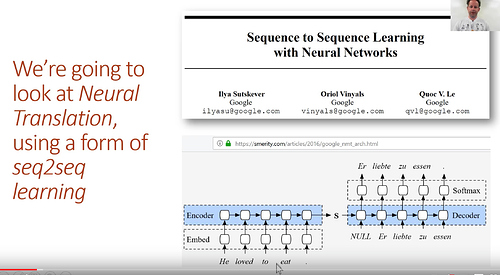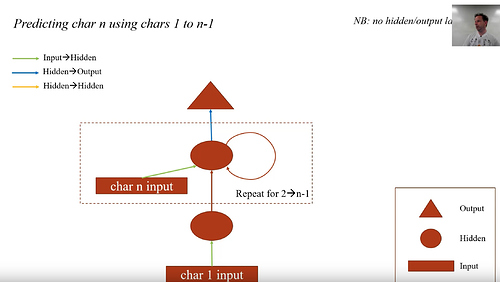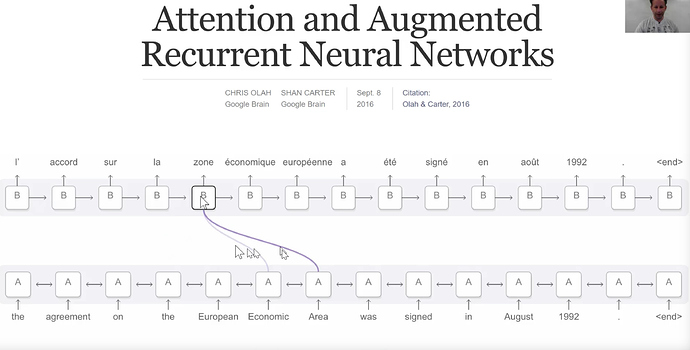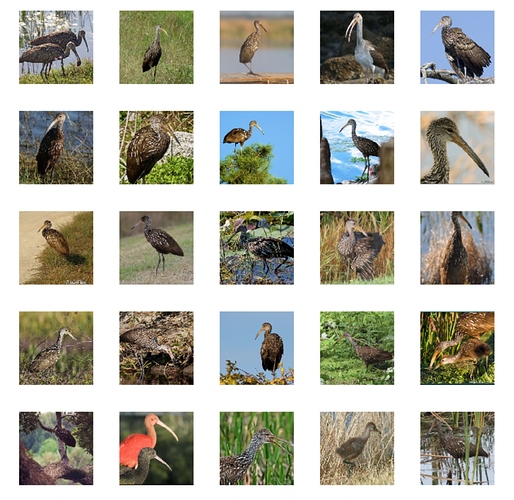Hi All,
Unfortunately Imagenet wouldnt fit on my paperspace instance, so I couldn’t recreate the devise portion of the lecture. Hope someone finds the notes userful.
- Tim
Sequence to Sequence Models
Machine translation -> Neural Translation
- 2015 : neural translation first appeared and wasn’t that performant compared to traditional statistical approach
- 2016 : neural translation outperforms other models
- Neural translation now on track similar to image recognition
Why a machine translation model if google has a translate service? - The reason is, the general idea of taking some input say french sentence, and outputing something of arbitrary length (say an english sentence) is very useful. Another example is taking in text and returning a summary.
Seq2Seq Benefits:
- We don’t have to fiddle with different options or parameters or feature engineering
- Distributed representation
- long-term state (instead of n-gram approaches)
- Text generation is more fluent
- Bi-directional LSTM with attention
Our process
Previously
- we had a decoder that took the RNN,
- took a MaxPool over all time
- MeanPool over all time
- value of RNN at last time step and put it through a linear layer
Going forward
- we start a sentence in english
- put it through an RNN
- *Language Model was easier because the number of output tokens corresponds exactly to the input tokens
- The tokens in the output will NOT correspond directly to the tokens in the input
- RNN encode input – > hidden state --> generate output sequence
- We know seq – > class (sentiment classifier)
- We know seq – > exact sequence (language model)
- Now seq --> seq
Quick Review of RNN
- RNN is a fully connected network (4 layers in the diagram)
- At each layer, it concatenates additional inputs
- This can be accomplished with linear layers and ReLus.
- Then we simplify the diagram, and made a loop as follows:
note that the hidden state h in this example is a vector
Stacking RNNs
Translating French into English
-
- Data <-
x = french,y = english sentences
- Data <-
-
- Architecture
-
- Suitable loss function
Data
Need a parallel corpus, we need pairs of french tuples vs. english tuples. Anything that goes through the UN has many translations. But for french, any canadian website has a french and english versions. So from scrubbing those websites we have a large set of data.
For bounding boxes, all the interesting stuff was in the loss function, for neural translation, all the interesting stuff will be in the architecture
Download the Fr model for spacy
!python -m spacy download fr
Collecting https://github.com/explosion/spacy-models/releases/download/fr_core_news_sm-2.0.0/fr_core_news_sm-2.0.0.tar.gz
e[?25l Downloading https://github.com/explosion/spacy-models/releases/download/fr_core_news_sm-2.0.0/fr_core_news_sm-2.0.0.tar.gz (39.8MB)
e[K 100% |████████████████████████████████| 39.8MB 24.3MB/s ta 0:00:01
e[?25hRequirement already satisfied (use --upgrade to upgrade): fr-core-news-sm==2.0.0 from https://github.com/explosion/spacy-models/releases/download/fr_core_news_sm-2.0.0/fr_core_news_sm-2.0.0.tar.gz in /home/paperspace/anaconda3/envs/fastai/lib/python3.6/site-packages
e[93m Linking successfule[0m
/home/paperspace/anaconda3/envs/fastai/lib/python3.6/site-packages/fr_core_news_sm
-->
/home/paperspace/anaconda3/envs/fastai/lib/python3.6/site-packages/spacy/data/fr
You can now load the model via spacy.load('fr')
Download the Data (2.4 GB) / Setup the directory
~ 30 mins to download at 1MB/sec
!wget http://www.statmt.org/wmt10/training-giga-fren.tar
--2018-05-15 00:49:07-- http://www.statmt.org/wmt10/training-giga-fren.tar
Resolving www.statmt.org (www.statmt.org)... 129.215.197.184
Connecting to www.statmt.org (www.statmt.org)|129.215.197.184|:80... connected.
HTTP request sent, awaiting response... 200 OK
Length: 2595102720 (2.4G) [application/x-tar]
Saving to: ‘training-giga-fren.tar’
training-giga-fren. 100%[===================>] 2.42G 149KB/s in 47m 17s
2018-05-15 01:36:24 (893 KB/s) - ‘training-giga-fren.tar’ saved [2595102720/2595102720]
!mkdir data/translate
!mkdir data/translate/tmp
!mv training-giga-fren.tar data/translate
!tar -xf data/translate/training-giga-fren.tar -C data/translate/
!gunzip data/translate/giga-fren.release2.fixed.en.gz
!gunzip data/translate/giga-fren.release2.fixed.fr.gz
!ls data/translate/
giga-fren.release2.fixed.en tmp
giga-fren.release2.fixed.fr training-giga-fren.tar
Import the libraries
%matplotlib inline
%reload_ext autoreload
%autoreload 2
import sys
sys.path.append('../')
from fastai.text import *
PATH = Path('data/translate')
TMP_PATH = PATH/'tmp'
TMP_PATH.mkdir(exist_ok=True)
fname='giga-fren.release2.fixed'
en_fname = PATH/f'{fname}.en'
fr_fname = PATH/f'{fname}.fr'
Training a Neural Model takes a long time
- Google’s model has 8 layers
- we are going to build a simpler one
- Instead of a general model we will translate French questions
Tokenizing and Preprocessing
# Question regex search filters
re_eq = re.compile('^(Wh[^?.!]+\?)')
re_fq = re.compile('^([^?.!]+\?)')
# grabbling lines from the english and french source texts
lines = ((re_eq.search(eq), re_fq.search(fq))
for eq, fq in zip(open(en_fname, encoding='utf-8'), open(fr_fname, encoding='utf-8')))
# isolate the questions
qs = [(e.group(), f.group()) for e,f in lines if e and f]
# save the questions for later
pickle.dump(qs, (PATH/'fr-en-qs.pkl').open('wb'))
# load in pickled questions
qs = pickle.load((PATH/'fr-en-qs.pkl').open('rb'))
qs[:5], len(qs)
([('What is light ?', 'Qu’est-ce que la lumière?'),
('Who are we?', 'Où sommes-nous?'),
('Where did we come from?', "D'où venons-nous?"),
('What would we do without it?', 'Que ferions-nous sans elle ?'),
('What is the absolute location (latitude and longitude) of Badger, Newfoundland and Labrador?',
'Quelle sont les coordonnées (latitude et longitude) de Badger, à Terre-Neuve-etLabrador?')],
52331)
Note that tokenizing for french is much different compared to english
# tokenize all the questions
en_qs,fr_qs = zip(*qs)
en_tok = Tokenizer.proc_all_mp(partition_by_cores(en_qs))
fr_tok = Tokenizer.proc_all_mp(partition_by_cores(fr_qs), 'fr')
en_tok[0], fr_tok[0]
(['what', 'is', 'light', '?'],
['qu’', 'est', '-ce', 'que', 'la', 'lumière', '?'])
# we are keeping tokens that are less than 30 chars
# The filter is applied on the english words, and the same tokens are kept for french
keep = np.array([len(o)<30 for o in en_tok])
en_tok = np.array(en_tok)[keep]
fr_tok = np.array(fr_tok)[keep]
# save our work
pickle.dump(en_tok, (PATH/'en_tok.pkl').open('wb'))
pickle.dump(fr_tok, (PATH/'fr_tok.pkl').open('wb'))
def toks2ids(tok,pre):
"""
Swaps out tokens for their index representations
"""
freq = Counter(p for o in tok for p in o)
itos = [o for o,c in freq.most_common(40000)]
# beginning of stream
itos.insert(0, '_bos_')
# padding
itos.insert(1, '_pad_')
# end of stream
itos.insert(2, '_eos_')
# unknown
itos.insert(3, '_unk')
# string to integer (STOI)
stoi = collections.defaultdict(lambda: 3, {v:k for k,v in enumerate(itos)})
ids = np.array([([stoi[o] for o in p] + [2]) for p in tok])
np.save(TMP_PATH/f'{pre}_ids.npy', ids)
pickle.dump(itos, open(TMP_PATH/f'{pre}_itos.pkl', 'wb'))
return ids,itos,stoi
def load_ids(pre):
"""
Loading the id mapping from disk
"""
ids = np.load(TMP_PATH/f'{pre}_ids.npy')
itos = pickle.load(open(TMP_PATH/f'{pre}_itos.pkl', 'rb'))
stoi = collections.defaultdict(lambda: 3, {v:k for k,v in enumerate(itos)})
return ids,itos,stoi
en_tok = pickle.load((PATH/'en_tok.pkl').open('rb'))
fr_tok = pickle.load((PATH/'fr_tok.pkl').open('rb'))
# simultaneously create and save token to indexing
en_ids,en_itos,en_stoi = toks2ids(en_tok,'en')
fr_ids,fr_itos,fr_stoi = toks2ids(fr_tok,'fr')
# loading lookups from scratch
en_ids,en_itos,en_stoi = load_ids('en')
fr_ids,fr_itos,fr_stoi = load_ids('fr')
Word Vectors Prep
Download word vectors
!wget https://s3-us-west-1.amazonaws.com/fasttext-vectors/wiki.en.zip
--2018-05-15 02:23:28-- https://s3-us-west-1.amazonaws.com/fasttext-vectors/wiki.en.zip
Resolving s3-us-west-1.amazonaws.com (s3-us-west-1.amazonaws.com)... 52.219.28.97
Connecting to s3-us-west-1.amazonaws.com (s3-us-west-1.amazonaws.com)|52.219.28.97|:443... connected.
HTTP request sent, awaiting response... 200 OK
Length: 10356881291 (9.6G) [application/zip]
Saving to: ‘wiki.en.zip’
wiki.en.zip 100%[===================>] 9.65G 64.1MB/s in 2m 44s
2018-05-15 02:26:12 (60.2 MB/s) - ‘wiki.en.zip’ saved [10356881291/10356881291]
!wget https://s3-us-west-1.amazonaws.com/fasttext-vectors/wiki.fr.zip
--2018-05-15 02:26:12-- https://s3-us-west-1.amazonaws.com/fasttext-vectors/wiki.fr.zip
Resolving s3-us-west-1.amazonaws.com (s3-us-west-1.amazonaws.com)... 52.219.24.113
Connecting to s3-us-west-1.amazonaws.com (s3-us-west-1.amazonaws.com)|52.219.24.113|:443... connected.
HTTP request sent, awaiting response... 200 OK
Length: 5975701653 (5.6G) [application/zip]
Saving to: ‘wiki.fr.zip’
wiki.fr.zip 100%[===================>] 5.56G 65.3MB/s in 1m 44s
2018-05-15 02:27:57 (54.6 MB/s) - ‘wiki.fr.zip’ saved [5975701653/5975701653]
!unzip data/translate/wiki.en.zip -C data/translate
Archive: data/translate/wiki.en.zip
inflating: wiki.en.vec
inflating: wiki.en.bin
!unzip data/translate/wiki.fr.zip -C data/translate
Archive: data/translate/wiki.fr.zip
inflating: wiki.fr.vec
inflating: wiki.fr.bin
#! pip install git+https://github.com/facebookresearch/fastText.git
Collecting git+https://github.com/facebookresearch/fastText.git
Cloning https://github.com/facebookresearch/fastText.git to /tmp/pip-req-build-dxq_lk8g
Requirement already satisfied (use --upgrade to upgrade): fasttext==0.8.22 from git+https://github.com/facebookresearch/fastText.git in /home/paperspace/anaconda3/envs/fastai/lib/python3.6/site-packages
Requirement already satisfied: pybind11>=2.2 in /home/paperspace/anaconda3/envs/fastai/lib/python3.6/site-packages (from fasttext==0.8.22) (2.2.3)
Requirement already satisfied: setuptools>=0.7.0 in /home/paperspace/anaconda3/envs/fastai/lib/python3.6/site-packages (from fasttext==0.8.22) (39.1.0)
Requirement already satisfied: numpy in /home/paperspace/anaconda3/envs/fastai/lib/python3.6/site-packages (from fasttext==0.8.22) (1.14.3)
Building wheels for collected packages: fasttext
Running setup.py bdist_wheel for fasttext ... e[?25ldone
e[?25h Stored in directory: /tmp/pip-ephem-wheel-cache-1ctapqn4/wheels/69/f8/19/7f0ab407c078795bc9f86e1f6381349254f86fd7d229902355
Successfully built fasttext
e[31mmkl-random 1.0.1 requires cython, which is not installed.e[0m
e[31mmkl-fft 1.0.0 requires cython, which is not installed.e[0m
e[31mkaggle-cli 0.12.13 has requirement lxml<4.1,>=4.0.0, but you'll have lxml 4.1.1 which is incompatible.e[0m
import fastText as ft
en_vecs = ft.load_model(str((PATH/'wiki.en.bin')))
fr_vecs = ft.load_model(str((PATH/'wiki.fr.bin')))
## create a lookup per word to get the associated word vector
def get_vecs(lang, ft_vecs):
vecd = {w:ft_vecs.get_word_vector(w) for w in ft_vecs.get_words()}
pickle.dump(vecd, open(PATH/f'wiki.{lang}.pkl','wb'))
return vecd
en_vecd = get_vecs('en', en_vecs)
fr_vecd = get_vecs('fr', fr_vecs)
en_vecd = pickle.load(open(PATH/'wiki.en.pkl','rb'))
fr_vecd = pickle.load(open(PATH/'wiki.fr.pkl','rb'))
dim_en_vec = len(en_vecd[','])
dim_fr_vec = len(fr_vecd[','])
dim_en_vec,dim_fr_vec
en_vecs = np.stack(list(en_vecd.values()))
en_vecs.mean(),en_vecs.std()
(0.0075652334, 0.29283327)
Want to exclude the extreme cases
enlen_90 = int(np.percentile([len(o) for o in en_ids], 99))
frlen_90 = int(np.percentile([len(o) for o in fr_ids], 97))
en_ids_tr = np.array([o[:enlen_90] for o in en_ids])
fr_ids_tr = np.array([o[:frlen_90] for o in fr_ids])
Create our Dataset, DataLoaders
class Seq2SeqDataset(Dataset):
def __init__(self, x, y): self.x,self.y = x,y
def __getitem__(self, idx): return A(self.x[idx], self.y[idx])
def __len__(self): return len(self.x)
# split the training and testing set
np.random.seed(42)
trn_keep = np.random.rand(len(en_ids_tr))>0.1
en_trn,fr_trn = en_ids_tr[trn_keep], fr_ids_tr[trn_keep]
en_val,fr_val = en_ids_tr[~trn_keep], fr_ids_tr[~trn_keep]
len(en_trn),len(en_val)
# create our training and validation sets
trn_ds = Seq2SeqDataset(fr_trn,en_trn)
val_ds = Seq2SeqDataset(fr_val,en_val)
# set our batch size
bs=125
"""
- Most of our preprocessing is complete so numworkers = 1
- Padding will pad the shorter phrases to be the same length
- Decoder, padding at the end
- Sampler - so we keep the similar sentences together (sorted by length)
"""
# arranges sentences so that similar lengths are close to each other
trn_samp = SortishSampler(en_trn, key=lambda x: len(en_trn[x]), bs=bs)
val_samp = SortSampler(en_val, key=lambda x: len(en_val[x]))
# create dataloaders
trn_dl = DataLoader(trn_ds, bs, transpose=True, transpose_y=True, num_workers=1,
pad_idx=1, pre_pad=False, sampler=trn_samp)
val_dl = DataLoader(val_ds, int(bs*1.6), transpose=True, transpose_y=True, num_workers=1,
pad_idx=1, pre_pad=False, sampler=val_samp)
md = ModelData(PATH, trn_dl, val_dl)
# Take a peek:
it = iter(trn_dl)
its = [next(it) for i in range(5)]
[(len(x),len(y)) for x,y in its]
[(31, 11), (21, 7), (21, 8), (33, 13), (33, 21)]
Architecture
A sequence will be parsed and encoded in the RNN and will be fed to a hidden state, and then will need to be passed to a decoder that will walk through the words one by one.
def create_emb(vecs, itos, em_sz):
"""
Creates embedding:
1. rows = number of vocab
2. cols = embedding size dimension
Will randomly initialize the embedding
"""
emb = nn.Embedding(len(itos), em_sz, padding_idx=1)
wgts = emb.weight.data
miss = []
# goes through the embedding and replace
# the initialized weights with existing word vectors
# multiply x3 to compensate for the stdev 0.3
for i,w in enumerate(itos):
try: wgts[i] = torch.from_numpy(vecs[w]*3)
except: miss.append(w)
print(len(miss),miss[5:10])
return emb
class Seq2SeqRNN(nn.Module):
def __init__(self, vecs_enc, itos_enc, em_sz_enc, vecs_dec, itos_dec, em_sz_dec, nh, out_sl, nl=2):
super().__init__()
# encoder (enc)
self.nl,self.nh,self.out_sl = nl,nh,out_sl
# for each word, pull up the 300M vector and create an embedding
self.emb_enc = create_emb(vecs_enc, itos_enc, em_sz_enc)
self.emb_enc_drop = nn.Dropout(0.15)
# Gru - similiar to LSTM
self.gru_enc = nn.GRU(em_sz_enc, nh, num_layers=nl, dropout=0.25)
self.out_enc = nn.Linear(nh, em_sz_dec, bias=False)
# decoder (dec)
self.emb_dec = create_emb(vecs_dec, itos_dec, em_sz_dec)
self.gru_dec = nn.GRU(em_sz_dec, em_sz_dec, num_layers=nl, dropout=0.1)
self.out_drop = nn.Dropout(0.35)
self.out = nn.Linear(em_sz_dec, len(itos_dec))
self.out.weight.data = self.emb_dec.weight.data
def forward(self, inp):
sl,bs = inp.size()
# initialize the hidden layer
h = self.initHidden(bs)
# run the input through our embeddings + apply dropout
emb = self.emb_enc_drop(self.emb_enc(inp))
# run it through the RNN layer
enc_out, h = self.gru_enc(emb, h)
# run the hidden state through our linear layer
h = self.out_enc(h)
# ==================================================
# Decoder version
# ==================================================
# starting with a 0 (or beginning of string _BOS_)
dec_inp = V(torch.zeros(bs).long())
res = []
# will loop as long as the longest english sentence
for i in range(self.out_sl):
# embedding - we are only looking at a section at time
# which is why the .unsqueeze is required
emb = self.emb_dec(dec_inp).unsqueeze(0)
# rnn - typically works with whole phrases, but we passing
# only 1 unit at a time in a loop
outp, h = self.gru_dec(emb, h)
# dropout
outp = self.out(self.out_drop(outp[0]))
res.append(outp)
# highest probability word
dec_inp = V(outp.data.max(1)[1])
# if its padding ,we are at the end of the sentence
if (dec_inp==1).all(): break
# stack the output into a single tensor
return torch.stack(res)
def initHidden(self, bs): return V(torch.zeros(self.nl, bs, self.nh))
def seq2seq_loss(input, target):
"""
Loss function - modified version of cross entropy
"""
sl,bs = target.size()
sl_in,bs_in,nc = input.size()
# sequence lenght could be shorter than the original
# need to add padding to even out the size
if sl>sl_in: input = F.pad(input, (0,0,0,0,0,sl-sl_in))
input = input[:sl]
return F.cross_entropy(input.view(-1,nc), target.view(-1))#, ignore_index=1)
nh,nl = 256,2
opt_fn = partial(optim.Adam, betas=(0.8, 0.99))
rnn = Seq2SeqRNN(fr_vecd, fr_itos, dim_fr_vec, en_vecd, en_itos, dim_en_vec, nh, enlen_90)
learn = RNN_Learner(md, SingleModel(to_gpu(rnn)), opt_fn=opt_fn)
learn.crit = seq2seq_loss
3097 ['l’', "d'", 't_up', 'd’', "qu'"]
1285 ["'s", '’s', "n't", 'n’t', ':']
Find the learning rate
learn.lr_find()
learn.sched.plot()
HBox(children=(IntProgress(value=0, description='Epoch', max=1), HTML(value='')))
67%|██████▋ | 243/362 [00:33<00:16, 7.20it/s, loss=34.9]
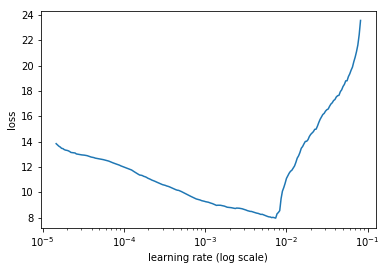
Fit the model (15-20 mins to train)
lr=3e-3
learn.fit(lr, 1, cycle_len=12, use_clr=(20,10))
HBox(children=(IntProgress(value=0, description='Epoch', max=12), HTML(value='')))
epoch trn_loss val_loss
0 5.112498 5.656483
1 4.331283 4.427685
2 3.890464 4.160612
3 3.613806 3.932455
4 3.428558 3.742856
5 3.352585 3.64594
6 2.988233 3.577188
7 2.938967 3.563399
8 2.957511 3.503175
9 2.996382 3.508209
10 2.666585 3.522618
11 2.6625 3.494461
[array([3.49446])]
learn.save('initial')
learn.load('initial')
Run the test case
x,y = next(iter(val_dl))
probs = learn.model(V(x))
preds = to_np(probs.max(2)[1])
for i in range(180,185):
print(' '.join([fr_itos[o] for o in x[:,i] if o != 1]))
print(' '.join([en_itos[o] for o in y[:,i] if o != 1]))
print(' '.join([en_itos[o] for o in preds[:,i] if o!=1]))
print('=======================')
quelles composantes des différents aspects de la performance devraient être mesurées , quelles données pertinentes recueillir et comment ? _eos_
which components within various performance areas should be measured , whatkinds of data are appropriate to collect , and how should this be done ? _eos_
what components of of components and and should be be be be and ? ? _eos_ _eos_
=======================
le premier ministre doit - il nommer un ministre d’ état à la santé mentale , à la maladie mentale et à la toxicomanie ? _eos_
what role can the federal government play to ensure that individuals with mental illness and addiction have access to the drug therapy they need ? _eos_
what is the minister of the minister to to to to the health mental mental mental and health mental health ? ? ? _eos_
=======================
quelles sont les conséquences de la hausse des formes d’ emploi non conformes aux normes chez les travailleurs hautement qualifiés et chez ceux qui occupent des emplois plus marginaux ? _eos_
what is the impact of growing forms of non - standard employment for highly skilled workers and for those employed in more marginal occupations ? _eos_
what are the implications of of of of workers workers workers workers workers workers workers than than than workers workers and ? ? ? ? ? _eos_ _eos_
=======================
que se produit - il si le gestionnaire n’ est pas en mesure de donner à l’ employé nommé pour une période déterminée un préavis de cessation d’ emploi d’ un mois ou
what happens if the manager is unable to or neglects to give a term employee the one - month notice of non - renewal ? _eos_
what if the employee employee employee employee employee the the the the or or or or the the ? ? ? ? _eos_
=======================
quelles personnes , communautés ou entités sont considérées comme potentiels i ) bénéficiaires de la protection et ii ) titulaires de droits ? _eos_
which persons , communities or entities are identified as potential ( i ) beneficiaries of protection and / or ( ii ) rights holders ? _eos_
who communities , , , , , , and and of protection protection protection protection ? ? ? _eos_ _eos_
=======================
Bi Directional
Take all your sequences and reverse them and make a “backwards model” then average the predictions. Note that with deeper models, not all levels may be bi-directional.
class Seq2SeqRNN_Bidir(nn.Module):
def __init__(self, vecs_enc, itos_enc, em_sz_enc, vecs_dec, itos_dec, em_sz_dec, nh, out_sl, nl=2):
super().__init__()
# encoding
self.emb_enc = create_emb(vecs_enc, itos_enc, em_sz_enc)
self.nl,self.nh,self.out_sl = nl,nh,out_sl
# ============================= ADD AN OPTION: BIDIRECTIONAL
self.gru_enc = nn.GRU(em_sz_enc, nh, num_layers=nl, dropout=0.25, bidirectional=True)
# need to have an extra layer because there's 2 directions
self.out_enc = nn.Linear(nh*2, em_sz_dec, bias=False)
self.drop_enc = nn.Dropout(0.05)
# decoding
self.emb_dec = create_emb(vecs_dec, itos_dec, em_sz_dec)
self.gru_dec = nn.GRU(em_sz_dec, em_sz_dec, num_layers=nl, dropout=0.1)
self.emb_enc_drop = nn.Dropout(0.15)
self.out_drop = nn.Dropout(0.35)
self.out = nn.Linear(em_sz_dec, len(itos_dec))
self.out.weight.data = self.emb_dec.weight.data
def forward(self, inp):
sl,bs = inp.size()
h = self.initHidden(bs)
emb = self.emb_enc_drop(self.emb_enc(inp))
enc_out, h = self.gru_enc(emb, h)
h = h.view(2,2,bs,-1).permute(0,2,1,3).contiguous().view(2,bs,-1)
h = self.out_enc(self.drop_enc(h))
dec_inp = V(torch.zeros(bs).long())
res = []
for i in range(self.out_sl):
emb = self.emb_dec(dec_inp).unsqueeze(0)
outp, h = self.gru_dec(emb, h)
outp = self.out(self.out_drop(outp[0]))
res.append(outp)
dec_inp = V(outp.data.max(1)[1])
if (dec_inp==1).all(): break
return torch.stack(res)
def initHidden(self, bs): return V(torch.zeros(self.nl*2, bs, self.nh))
rnn = Seq2SeqRNN_Bidir(fr_vecd, fr_itos, dim_fr_vec, en_vecd, en_itos, dim_en_vec, nh, enlen_90)
learn = RNN_Learner(md, SingleModel(to_gpu(rnn)), opt_fn=opt_fn)
learn.crit = seq2seq_loss
learn.fit(lr, 1, cycle_len=12, use_clr=(20,10))
3097 ['l’', "d'", 't_up', 'd’', "qu'"]
1285 ["'s", '’s', "n't", 'n’t', ':']
Teacher Forcing
When the model starts learning, it starts out not knowing anything about the different languages. It will eventually get better, but in the beginning it doesn’t have a lot to work with.
- idea - what if we force feed the correct answer in the beginnging?
class Seq2SeqRNN_TeacherForcing(nn.Module):
def __init__(self, vecs_enc, itos_enc, em_sz_enc, vecs_dec, itos_dec, em_sz_dec, nh, out_sl, nl=2):
super().__init__()
# encoding
self.emb_enc = create_emb(vecs_enc, itos_enc, em_sz_enc)
self.nl,self.nh,self.out_sl = nl,nh,out_sl
self.gru_enc = nn.GRU(em_sz_enc, nh, num_layers=nl, dropout=0.25)
self.out_enc = nn.Linear(nh, em_sz_dec, bias=False)
# decoding
self.emb_dec = create_emb(vecs_dec, itos_dec, em_sz_dec)
self.gru_dec = nn.GRU(em_sz_dec, em_sz_dec, num_layers=nl, dropout=0.1)
# dropout
self.emb_enc_drop = nn.Dropout(0.15)
self.out_drop = nn.Dropout(0.35)
self.out = nn.Linear(em_sz_dec, len(itos_dec))
self.out.weight.data = self.emb_dec.weight.data
self.pr_force = 1.
def forward(self, inp, y=None):
sl,bs = inp.size()
h = self.initHidden(bs)
emb = self.emb_enc_drop(self.emb_enc(inp))
enc_out, h = self.gru_enc(emb, h)
h = self.out_enc(h)
dec_inp = V(torch.zeros(bs).long())
res = []
for i in range(self.out_sl):
emb = self.emb_dec(dec_inp).unsqueeze(0)
outp, h = self.gru_dec(emb, h)
outp = self.out(self.out_drop(outp[0]))
res.append(outp)
dec_inp = V(outp.data.max(1)[1])
if (dec_inp==1).all(): break
# Given some probability we will swap out the random word
# with the actual correct answer
# at the start of training, we will have a high prob
# we will then decrease probability of forcing as
# time goes on
if (y is not None) and (random.random()<self.pr_force):
if i>=len(y): break
dec_inp = y[i]
return torch.stack(res)
def initHidden(self, bs): return V(torch.zeros(self.nl, bs, self.nh))
A note on stepper
class Stepper():
def __init__(self, m, opt, crit, clip=0, reg_fn=None, fp16=False, loss_scale=1):
self.m,self.opt,self.crit,self.clip,self.reg_fn = m,opt,crit,clip,reg_fn
self.fp16 = fp16
self.reset(True)
if self.fp16: self.fp32_params = copy_model_to_fp32(m, opt)
self.loss_scale = loss_scale
def reset(self, train=True):
if train: apply_leaf(self.m, set_train_mode)
else: self.m.eval()
if hasattr(self.m, 'reset'):
self.m.reset()
if self.fp16: self.fp32_params = copy_model_to_fp32(self.m, self.opt)
# ======================================================
# This section will be replaced Seq2Seq
# ======================================================
def step(self, xs, y, epoch):
xtra = []
# ========= calls the model
output = self.m(*xs)
if isinstance(output,tuple): output,*xtra = output
# ========= zeroes out gradient
if self.fp16: self.m.zero_grad()
else: self.opt.zero_grad()
# ========= calculates loss
loss = raw_loss = self.crit(output, y)
if self.loss_scale != 1: assert(self.fp16); loss = loss*self.loss_scale
if self.reg_fn: loss = self.reg_fn(output, xtra, raw_loss)
# ========= calls backwards
loss.backward()
if self.fp16: update_fp32_grads(self.fp32_params, self.m)
if self.loss_scale != 1:
for param in self.fp32_params: param.grad.data.div_(self.loss_scale)
# ========= gradient clipping if necessary
if self.clip:
if IS_TORCH_04: nn.utils.clip_grad_norm_(trainable_params_(self.m), self.clip)
else: nn.utils.clip_grad_norm(trainable_params_(self.m), self.clip)
# ========= calls optimizer
self.opt.step()
if self.fp16:
copy_fp32_to_model(self.m, self.fp32_params)
torch.cuda.synchronize()
return torch_item(raw_loss.data)
# ======================================================
# ======================================================
def evaluate(self, xs, y):
preds = self.m(*xs)
if isinstance(preds,tuple): preds=preds[0]
return preds, self.crit(preds, y)
Modify the step function
class Seq2SeqStepper(Stepper):
"""
By default Stepper class calls 'step'
"""
def step(self, xs, y, epoch):
# replace pr_force with something that
# gradually decreases, and eventually goes to 0
self.m.pr_force = (10-epoch)*0.1 if epoch<10 else 0
# === the same
xtra = []
output = self.m(*xs, y)
if isinstance(output,tuple): output,*xtra = output
self.opt.zero_grad()
loss = raw_loss = self.crit(output, y)
if self.reg_fn: loss = self.reg_fn(output, xtra, raw_loss)
loss.backward()
if self.clip: # Gradient clipping
nn.utils.clip_grad_norm(trainable_params_(self.m), self.clip)
self.opt.step()
return raw_loss.data[0]
rnn = Seq2SeqRNN_TeacherForcing(fr_vecd, fr_itos, dim_fr_vec, en_vecd, en_itos, dim_en_vec, nh, enlen_90)
learn = RNN_Learner(md, SingleModel(to_gpu(rnn)), opt_fn=opt_fn)
learn.crit = seq2seq_loss
learn.fit(lr, 1, cycle_len=12, use_clr=(20,10), stepper=Seq2SeqStepper)
Attention Model
Our RNN model exports the hidden state at every time step, along with the hidden state at the last time step. Initially we are only using the LAST hidden state to ‘decode’ into another phrase
enc_out, h = self.gru_enc(emb, h)
h = self.out_enc(h)
can we use the rest of those hidden states?
goal: use some % of all hidden states and add another trainable parameter to find good answers in the model
idea - expecting the entire sentence to be summarized into a vector is a lot. Instead of having a hidden state at the end of the phrase, we can have a hidden state after every single word. So how do we use the hidden information after every word.
def rand_t(*sz): return torch.randn(sz)/math.sqrt(sz[0])
def rand_p(*sz): return nn.Parameter(rand_t(*sz))
class Seq2SeqAttnRNN(nn.Module):
def __init__(self, vecs_enc, itos_enc, em_sz_enc, vecs_dec, itos_dec, em_sz_dec, nh, out_sl, nl=2):
super().__init__()
self.emb_enc = create_emb(vecs_enc, itos_enc, em_sz_enc)
self.nl,self.nh,self.out_sl = nl,nh,out_sl
self.gru_enc = nn.GRU(em_sz_enc, nh, num_layers=nl, dropout=0.25)
self.out_enc = nn.Linear(nh, em_sz_dec, bias=False)
self.emb_dec = create_emb(vecs_dec, itos_dec, em_sz_dec)
self.gru_dec = nn.GRU(em_sz_dec, em_sz_dec, num_layers=nl, dropout=0.1)
self.emb_enc_drop = nn.Dropout(0.15)
self.out_drop = nn.Dropout(0.35)
self.out = nn.Linear(em_sz_dec*2, len(itos_dec))
self.out.weight.data = self.emb_dec.weight.data
# random matrix
self.W1 = rand_p(nh, em_sz_dec)
# this is the mini NN that will calculate the weights
self.l2 = nn.Linear(em_sz_dec, em_sz_dec)
self.l3 = nn.Linear(em_sz_dec+nh, em_sz_dec)
self.V = rand_p(em_sz_dec)
def forward(self, inp, y=None, ret_attn=False):
sl,bs = inp.size()
h = self.initHidden(bs)
emb = self.emb_enc_drop(self.emb_enc(inp))
enc_out, h = self.gru_enc(emb, h)
h = self.out_enc(h)
dec_inp = V(torch.zeros(bs).long())
res,attns = [],[]
w1e = enc_out @ self.W1
for i in range(self.out_sl):
# create a little neural network
# will use softmax to generate the
# probabilities
# take last layers hidden state put into lin layer
w2h = self.l2(h[-1])
# nonlinear activation
u = F.tanh(w1e + w2h)
# matrix multiply
a = F.softmax(u @ self.V, 0)
attns.append(a)
# take a weighted average. Use the weights from NN
# note we are using all the encoder states
Xa = (a.unsqueeze(2) * enc_out).sum(0)
emb = self.emb_dec(dec_inp)
# adding the hidden states to the encoder weights
wgt_enc = self.l3(torch.cat([emb, Xa], 1))
outp, h = self.gru_dec(wgt_enc.unsqueeze(0), h)
outp = self.out(self.out_drop(outp[0]))
res.append(outp)
dec_inp = V(outp.data.max(1)[1])
if (dec_inp==1).all(): break
if (y is not None) and (random.random()<self.pr_force):
if i>=len(y): break
dec_inp = y[i]
res = torch.stack(res)
if ret_attn: res = res,torch.stack(attns)
return res
def initHidden(self, bs): return V(torch.zeros(self.nl, bs, self.nh))
rnn = Seq2SeqAttnRNN(fr_vecd, fr_itos, dim_fr_vec, en_vecd, en_itos, dim_en_vec, nh, enlen_90)
learn = RNN_Learner(md, SingleModel(to_gpu(rnn)), opt_fn=opt_fn)
learn.crit = seq2seq_loss
lr=2e-3
3097 ['l’', "d'", 't_up', 'd’', "qu'"]
1285 ["'s", '’s', "n't", 'n’t', ':']
#learn.fit(lr, 1, cycle_len=15, use_clr=(20,10), stepper=Seq2SeqStepper)
Test the Attention Model
x,y = next(iter(val_dl))
probs,attns = learn.model(V(x),ret_attn=True)
preds = to_np(probs.max(2)[1])
for i in range(180,190):
print(' '.join([fr_itos[o] for o in x[:,i] if o != 1]))
print(' '.join([en_itos[o] for o in y[:,i] if o != 1]))
print(' '.join([en_itos[o] for o in preds[:,i] if o!=1]))
print()
Lets check the attention distribution
attn = to_np(attns[...,180])
fig, axes = plt.subplots(3, 3, figsize=(15, 10))
for i,ax in enumerate(axes.flat):
ax.plot(attn[i])
Incorporate all the ideas
- Bidirectional
- Teacher Forcing
- Attention
class Seq2SeqRNN_All(nn.Module):
def __init__(self, vecs_enc, itos_enc, em_sz_enc, vecs_dec, itos_dec, em_sz_dec, nh, out_sl, nl=2):
super().__init__()
self.emb_enc = create_emb(vecs_enc, itos_enc, em_sz_enc)
self.nl,self.nh,self.out_sl = nl,nh,out_sl
self.gru_enc = nn.GRU(em_sz_enc, nh, num_layers=nl, dropout=0.25, bidirectional=True)
self.out_enc = nn.Linear(nh*2, em_sz_dec, bias=False)
self.drop_enc = nn.Dropout(0.25)
self.emb_dec = create_emb(vecs_dec, itos_dec, em_sz_dec)
self.gru_dec = nn.GRU(em_sz_dec, em_sz_dec, num_layers=nl, dropout=0.1)
self.emb_enc_drop = nn.Dropout(0.15)
self.out_drop = nn.Dropout(0.35)
self.out = nn.Linear(em_sz_dec, len(itos_dec))
self.out.weight.data = self.emb_dec.weight.data
self.W1 = rand_p(nh*2, em_sz_dec)
self.l2 = nn.Linear(em_sz_dec, em_sz_dec)
self.l3 = nn.Linear(em_sz_dec+nh*2, em_sz_dec)
self.V = rand_p(em_sz_dec)
def forward(self, inp, y=None):
sl,bs = inp.size()
h = self.initHidden(bs)
emb = self.emb_enc_drop(self.emb_enc(inp))
enc_out, h = self.gru_enc(emb, h)
h = h.view(2,2,bs,-1).permute(0,2,1,3).contiguous().view(2,bs,-1)
h = self.out_enc(self.drop_enc(h))
dec_inp = V(torch.zeros(bs).long())
res,attns = [],[]
w1e = enc_out @ self.W1
for i in range(self.out_sl):
w2h = self.l2(h[-1])
u = F.tanh(w1e + w2h)
a = F.softmax(u @ self.V, 0)
attns.append(a)
Xa = (a.unsqueeze(2) * enc_out).sum(0)
emb = self.emb_dec(dec_inp)
wgt_enc = self.l3(torch.cat([emb, Xa], 1))
outp, h = self.gru_dec(wgt_enc.unsqueeze(0), h)
outp = self.out(self.out_drop(outp[0]))
res.append(outp)
dec_inp = V(outp.data.max(1)[1])
if (dec_inp==1).all(): break
if (y is not None) and (random.random()<self.pr_force):
if i>=len(y): break
dec_inp = y[i]
return torch.stack(res)
def initHidden(self, bs): return V(torch.zeros(self.nl*2, bs, self.nh))
Devise
What if we could get a set of word and images to be in the same space
beagle dog input --> model A --> jumbo jet
beagle dog input --> model B --> corgie
Consider models A and B. In traditional terms, both of these models are wrong (have the same score). But in word vector space, corgie (a dog) is much closer to beagle, so model B is much better than model A
idea - train a model that finds a word vector for the word you want. Instead of class.
%matplotlib inline
%reload_ext autoreload
%autoreload 2
Import our libraries
import sys
sys.path.append('../')
from fastai.conv_learner import *
torch.backends.cudnn.benchmark=True
import fastText as ft
import torchvision.transforms as transforms
normalize = transforms.Normalize(mean=[0.485, 0.456, 0.406], std=[0.229, 0.224, 0.225])
tfms = transforms.Compose([
transforms.RandomResizedCrop(224),
transforms.RandomHorizontalFlip(),
transforms.ToTensor(),
normalize,
])
Setup our paths
PATH = Path('data/imagenet/')
TMP_PATH = PATH/'tmp'
TRANS_PATH = Path('data/translate/')
PATH_TRN = PATH/'train'
fname = 'valid/n01440764/ILSVRC2012_val_00007197.JPEG'
Load the Word Vectors
ft_vecs = ft.load_model(str((TRANS_PATH/'wiki.en.bin')))
ft_vecs.get_word_vector('king')[:10]
array([ 0.03259, -0.18164, -0.29049, -0.10506, -0.16712, -0.07748, -0.5661 , -0.08622, -0.00216, 0.15366],
dtype=float32)
ft_words = ft_vecs.get_words(include_freq=True)
ft_word_dict = {k:v for k,v in zip(*ft_words)}
ft_words = sorted(ft_word_dict.keys(), key=lambda x: ft_word_dict[x])
len(ft_words)
2519370
Get Imagenet Classes
from fastai.io import get_data
CLASSES_FN = 'imagenet_class_index.json'
get_data(f'http://files.fast.ai/models/{CLASSES_FN}', TMP_PATH/CLASSES_FN)
imagenet_class_index.json: 41.0kB [00:00, 162kB/s]
Get all nouns in English (WORDNET)
WORDS_FN = 'classids.txt'
get_data(f'http://files.fast.ai/data/{WORDS_FN}', PATH/WORDS_FN)
classids.txt: 1.74MB [00:01, 1.70MB/s]
Create imagenet class number to words
class_dict = json.load((TMP_PATH/CLASSES_FN).open())
classids_1k = dict(class_dict.values())
nclass = len(class_dict); nclass
1000
class_dict['0']
['n01440764', 'tench']
Wordnet class number to Nouns
classid_lines = (PATH/WORDS_FN).open().readlines()
classid_lines[:5]
['n00001740 entity\n',
'n00001930 physical_entity\n',
'n00002137 abstraction\n',
'n00002452 thing\n',
'n00002684 object\n']
classids = dict(l.strip().split() for l in classid_lines)
len(classids),len(classids_1k)
(82115, 1000)
Look up all teh nouns in FastText
lc_vec_d = {w.lower(): ft_vecs.get_word_vector(w) for w in ft_words[-1000000:]}
syn_wv = [(k, lc_vec_d[v.lower()]) for k,v in classids.items()
if v.lower() in lc_vec_d]
syn_wv_1k = [(k, lc_vec_d[v.lower()]) for k,v in classids_1k.items()
if v.lower() in lc_vec_d]
syn2wv = dict(syn_wv)
len(syn2wv)
49469
Save the lookups
pickle.dump(syn2wv, (TMP_PATH/'syn2wv.pkl').open('wb'))
pickle.dump(syn_wv_1k, (TMP_PATH/'syn_wv_1k.pkl').open('wb'))
CHECKPOINT load
syn2wv = pickle.load((TMP_PATH/'syn2wv.pkl').open('rb'))
syn_wv_1k = pickle.load((TMP_PATH/'syn_wv_1k.pkl').open('rb'))
Due to Imagenet Localization data = 157GB, will not run the rest of this code
images = []
img_vecs = []
for d in (PATH/'train').iterdir():
if d.name not in syn2wv: continue
# grab the fast txt word vector
vec = syn2wv[d.name]
for f in d.iterdir():
images.append(str(f.relative_to(PATH)))
img_vecs.append(vec)
n_val=0
for d in (PATH/'valid').iterdir():
if d.name not in syn2wv: continue
vec = syn2wv[d.name]
for f in d.iterdir():
images.append(str(f.relative_to(PATH)))
img_vecs.append(vec)
n_val += 1
img_vecs = np.stack(img_vecs)
img_vecs.shapeb
pickle.dump(images, (TMP_PATH/'images.pkl').open('wb'))
pickle.dump(img_vecs, (TMP_PATH/'img_vecs.pkl').open('wb'))
# load the images for ImageNet
images = pickle.load((TMP_PATH/'images.pkl').open('rb'))
# have the corresponding vector for each image
img_vecs = pickle.load((TMP_PATH/'img_vecs.pkl').open('rb'))
Create the model architecture + datasets
n = len(images); n
val_idxs = list(range(n-28650, n))
tfms = tfms_from_model(arch, 224, transforms_side_on, max_zoom=1.1)
# we can pass all the names from imagenet + word vecs
# then pass the indexes
# continuous = True - since we are predicting vectors
md = ImageClassifierData.from_names_and_array(PATH, images, img_vecs, val_idxs=val_idxs,
classes=None, tfms=tfms, continuous=True, bs=256)
"""
arch - resnet 50
md.c - how many classes
is_multi - not multiclass
is_reg - is regression
xtra_fc - extra fully connected layers
ps - how much dropout do you want?
*note no softmax
"""
arch = resnet50
models = ConvnetBuilder(arch, md.c, is_multi=False, is_reg=True, xtra_fc=[1024], ps=[0.2,0.2])
learn = ConvLearner(md, models, precompute=True)
learn.opt_fn = partial(optim.Adam, betas=(0.9,0.99))
# loss function - L1 loss is the difference
# but since we are doing high-dimensional vectors, most of the items
# are on the outside and the distance metric isn't the best metricb
def cos_loss(inp,targ): return 1 - F.cosine_similarity(inp,targ).mean()
learn.crit = cos_loss
Train the model with precompute=True to cut down on training time
Quoted at 1+ hour length
learn.lr_find(start_lr=1e-4, end_lr=1e15)
learn.sched.plot()
lr = 1e-2
wd = 1e-7
learn.precompute=True
learn.fit(lr, 1, cycle_len=20, wds=wd, use_clr=(20,10))
learn.bn_freeze(True)
learn.fit(lr, 1, cycle_len=20, wds=wd, use_clr=(20,10))
lrs = np.array([lr/1000,lr/100,lr])
learn.precompute=False
learn.freeze_to(1)
learn.save('pre0')
learn.load('pre0')
Image Searching
syns, wvs = list(zip(*syn_wv_1k))
wvs = np.array(wvs)
%time pred_wv = learn.predict()
Let’s take a look at some of the pictures
denorm = md.val_ds.denorm
def show_img(im, figsize=None, ax=None):
if not ax: fig,ax = plt.subplots(figsize=figsize)
ax.imshow(im)
ax.axis('off')
return ax
def show_imgs(ims, cols, figsize=None):
fig,axes = plt.subplots(len(ims)//cols, cols, figsize=figsize)
for i,ax in enumerate(axes.flat): show_img(ims[i], ax=ax)
plt.tight_layout()
start=300
show_imgs(denorm(md.val_ds[start:start+25][0]), 5, (10,10))
Use Nearest Neighbors search - 300D vector, what are the closest neighbors?
# super fast library, that searches very quickly
import nmslib
def create_index(a):
index = nmslib.init(space='angulardist')
index.addDataPointBatch(a)
index.createIndex()
return index
def get_knns(index, vecs):
return zip(*index.knnQueryBatch(vecs, k=10, num_threads=4))
def get_knn(index, vec): return index.knnQuery(vec, k=10)
---------------------------------------------------------------------------
ModuleNotFoundError Traceback (most recent call last)
<ipython-input-25-426fb459f5cb> in <module>()
1 # super fast library, that searches very quickly
----> 2 import nmslib
3
4 def create_index(a):
5 index = nmslib.init(space='angulardist')
ModuleNotFoundError: No module named 'nmslib'
nn_wvs = create_index(wvs)
idxs,dists = get_knns(nn_wvs, pred_wv)
[[classids[syns[id]] for id in ids[:3]] for ids in idxs[start:start+10]]
What if we now bring in WordNet
all_syns, all_wvs = list(zip(*syn2wv.items()))
all_wvs = np.array(all_wvs)
nn_allwvs = create_index(all_wvs)
idxs,dists = get_knns(nn_allwvs, pred_wv)
[[classids[all_syns[id]] for id in ids[:3]] for ids in idxs[start:start+10]]
Text --> Image Search
nn_predwv = create_index(pred_wv)
en_vecd = pickle.load(open(TRANS_PATH/'wiki.en.pkl','rb'))
## get the vector for boat
vec = en_vecd['boat']
idxs,dists = get_knn(nn_predwv, vec)
# then we only pull images who's vector is close to our 'boat' vector
show_imgs([open_image(PATH/md.val_ds.fnames[i]) for i in idxs[:3]], 3, figsize=(9,3));
vec = (en_vecd['engine'] + en_vecd['boat'])/2
idxs,dists = get_knn(nn_predwv, vec)
show_imgs([open_image(PATH/md.val_ds.fnames[i]) for i in idxs[:3]], 3, figsize=(9,3));
vec = (en_vecd['sail'] + en_vecd['boat'])/2
idxs,dists = get_knn(nn_predwv, vec)
show_imgs([open_image(PATH/md.val_ds.fnames[i]) for i in idxs[:3]], 3, figsize=(9,3));
